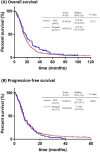Single-institute comparison of the efficacy of systemic chemotherapy for oesophagogastric junction adenocarcinoma and stomach adenocarscinoma in a metastatic setting
- PMID: 32273288
- PMCID: PMC7245385
- DOI: 10.1136/esmoopen-2019-000595
Single-institute comparison of the efficacy of systemic chemotherapy for oesophagogastric junction adenocarcinoma and stomach adenocarscinoma in a metastatic setting
Abstract
Background: Different approaches are used to treat resectable tumours in patients having adenocarcinoma at the oesophagogastrointestinal junction (EGJ) or in the stomach. However, there is limited information about treatment efficacy for patients at metastatic stage. A recent molecular analysis of upper gastrointestinal tract adenocarcinoma revealed that the anatomical location can influence the molecular backgrounds of tumours. This study sought to elucidate whether different therapeutic approaches should be used for EGJ tumours relative to those in the stomach.
Methods: This retrospective cohort study was conducted at a single institute in Japan. Patients having metastatic or recurrent adenocarcinoma in the EGJ or stomach who underwent platinum doublet chemotherapy between January 2007 and August 2014 were enrolled. Patients in the EGJ tumour group had tumours having an epicentre within 2 cm proximal or 5 cm distal to the estimated anatomical EGJ and cardia.
Results: Among 378 consecutively enrolled patients, 61 were grouped into the EGJ group and the remainder comprised the stomach group. The EGJ group had more men and lower incidence of diffuse type and Borrmann type IV tumours and peritoneum metastasis compared with the stomach group. The median overall survival of patients in the EGJ and stomach groups was similar (17.3 months (95% CI 13.5 to 23.2) vs 14.5 months (95% CI 13.3 to 16.4)). No statistically significant difference was observed in progression-free survival. Although the overall postprogression survival differed significantly between the EGJ and stomach groups (8.2 months (95% CI 5.7 to 12.7) vs 7.1 months (95% CI 6.1 to 7.8)), on grouping patients by histological type, the two groups exhibited similar postprogression survival. Multivariate analysis demonstrated that diffuse-type histology, higher serum CA19-9 levels and neutrophil to lymphocyte ratios were independent poor prognostic factors.
Conclusions: Different clinicopathological features of EGJ adenocarcinoma were not associated with clinical outcomes of platinum doublet chemotherapy. Histological subtype rather than anatomical location has more significance for treatment decisions for advanced gastric cancers.
Keywords: HER2 status; diffuse-type gastric cancer; platinum doublet chemotherapy; primary tumor location.
© Author (s) (or their employer(s)) 2020. Re-use permitted under CC BY-NC. No commercial re-use. Published by BMJ on behalf of the European Society for Medical Oncology.
Conflict of interest statement
Competing interests: None declared.
Figures



Comment in
-
Systemic chemotherapy for gastro-oesophagogastric junction adenocarcinoma and stomach adenocarcinoma in a metastatic setting.ESMO Open. 2020 Jul;5(4):e000802. doi: 10.1136/esmoopen-2020-000802. ESMO Open. 2020. PMID: 32646964 Free PMC article. No abstract available.
References
-
- Sehdev A, Catenacci DVT. Gastroesophageal cancer: focus on epidemiology, classification, and staging. Discov Med 2013;16:103–11. - PubMed
-
- Yamashita H, Seto Y, Sano T, et al. . Japanese gastric cancer association and the Japan esophageal Society. Results of a nation-wide retrospective study of lymphadenectomy for esophagogastric junction carcinoma. Gastric Cancer 2017;20:69–83. - PubMed
MeSH terms
Supplementary concepts
LinkOut - more resources
Full Text Sources
Medical
Research Materials
Miscellaneous

